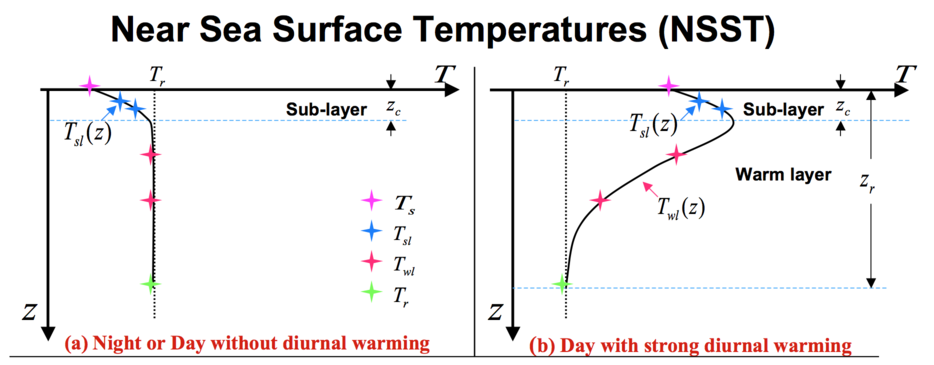Near Sea Surface Temperature (NSST) is a temperature profile just below the sea surface. The GFS NSST scheme is used to forecast the NSST for two main purposes: supply SSTs to the atmospheric model for the calculation of air-sea heat and moisture fluxes and providing a sub-layer temperature profile forecast for use as a first guess in the Gridpoint Statistical Interpolator (GSI) data assimilation code.
The GFS NSST scheme was initially developed at NCEP by Xu Li in 2007, and subsequently received contributions by S. Moorthi, Y.-T. Hu and J. Derber, leading to operational implementation in the GFS in 2017 ([53] and [52]). The GFS NSST scheme predicts the vertical profile of sea temperature between the surface and a reference level (zr), which is on the order of 5 m. Only two physical process are considered in this scheme: diurnal thermocline layer warming and thermal skin layer (also known as sub-layer) cooling. All other process that could influence NSST are ignored in this simple scheme.
This profile is a composed by subdividing the near-surface layer in three parts
T(z) = Tr + T’w (z) + T’c (z),
where
Ts = T(z=0) is the SST
T’c (z) is the temperature profile in the skin layer (0 < z <= zc)
T’w (z) is the temperature profile in the warm layer (0 < z <= zr)
Tr is the reference temperature
zc is the depth of the skin layer
Prediction for the skin layer is made using the Thermal Skin-layer Model (TSM), while prediction for the thermocline is based on the Diurnal Thermocline Model (DTM), both with an origin on [21]. Atmospheric inputs include short- and long-wave radiation, surface pressure, surface layer winds, temperature and specific humidity, and rainfall.
